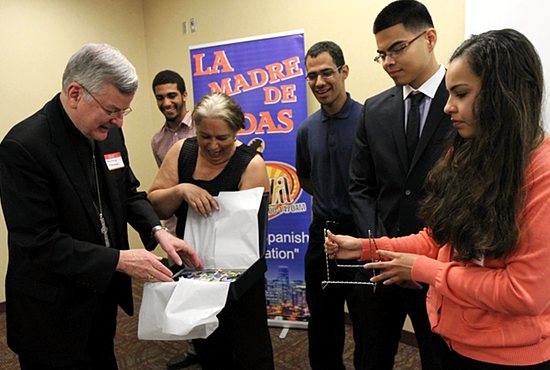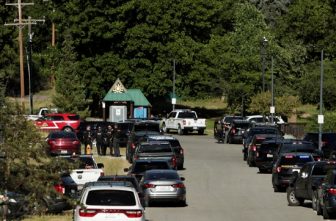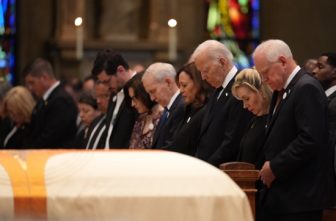
A variety of community leaders in the Twin Cities gathered for one of what they say will be many meetings to address the achievement gap for Latino students in Minnesota, which data shows is the highest in the nation.
Archbishop John Nienstedt opened the first education summit of the annual La Familia Latino Family Festival and Expo Sept. 27 in West St. Paul by telling the crowd of about 100 that while there are many solutions to the achievement gap, perhaps the most important is advocating for parents to have more choices when it comes to their child’s education.
“For those who do not live in an area with successful, safe public schools, or who are not able to afford private school tuition, choice can seem elusive, and an excellent education may feel like an opportunity for everyone else but not for them,” Archbishop Nienstedt said. “Educational choice can feel especially out of reach for families in our minority communities or those of lesser economic means.”
Claudia Correa is one such parent, having emigrated from Argentina in 2001. Her two oldest children started their education in public school, although she sought a Catholic education for them.
“Even when [Catholic school] tuition was so cheap, I still couldn’t afford it,” Correa said.
For the last nine years, Correa has worked as an office assistant at Risen Christ School in south Minneapolis, where she enrolled two of her children. Although the annual tuition at the K-8 school — less than $1,000 — is a sacrifice for her and others, Correa said the benefits of a Catholic education for her children are worth it.
“[The teachers are] more conscious about society, people, the Church, about everything,” she said. “I see the big difference.”
Correa noted her daughter’s improved reading skills at Risen Christ School, which this year became the first dual immersion school in the state — students learn the same content in Spanish and English, which reinforces the curriculum and enhances vocabulary skills in both languages.
“I feel so happy for Latinos who want to come here for the Spanish and English at the same time,” Correa said.
Archbishop Nienstedt said that ultimately, what’s best for children’s education should be the foremost concern for parents, educators, advocates and lawmakers. That’s why Minnesota’s bishops will work with the Minnesota Catholic Conference, their public policy arm, to call on legislators to increase access to the range of school options that exist.
“A funding model that allows parents to freely choose where their children attend school will shift the focus of the debate and to place it first and foremost on the student, rather than the system,” Archbishop Nienstedt said.
Minnesota Catholic Conference was among the sponsors of the education summit. Executive the Director Jason Adkins echoed the archbishop, saying the issue boils down to students’ well-being. He explained that although Minnesota was an early leader in education, where it has lagged behind is in providing greater financial tools in order for students to access non-public education, which includes a variety of options, not just Catholic schools.
“It’s our firm position that no student should be denied the best educational opportunities available simply because of their ZIP code,” Adkins said. “We believe that giving parents real and actual options empowers them as educators and creates an environment where kids can really flourish. We shouldn’t be trapping kids in failing schools.”
Adkins said there’s new momentum to propose various pieces of educational choice legislation. Ideally, the state would create a system of scholarships for all types of students. That might include vouchers, savings accounts or tax credits. The latter has had bipartisan support in the past, Adkins said.
The reasons for the state’s high achievement gap, Adkins explained, range from students being concentrated in schools that are under-performing to poverty issues.
“We do have school choice in Minnesota: We have preschool choice, and choice at the college level . . . why won’t school choice work for K-12?” he said.





‘We are in this together’: Recent Supreme Court rulings support parents in their vocation